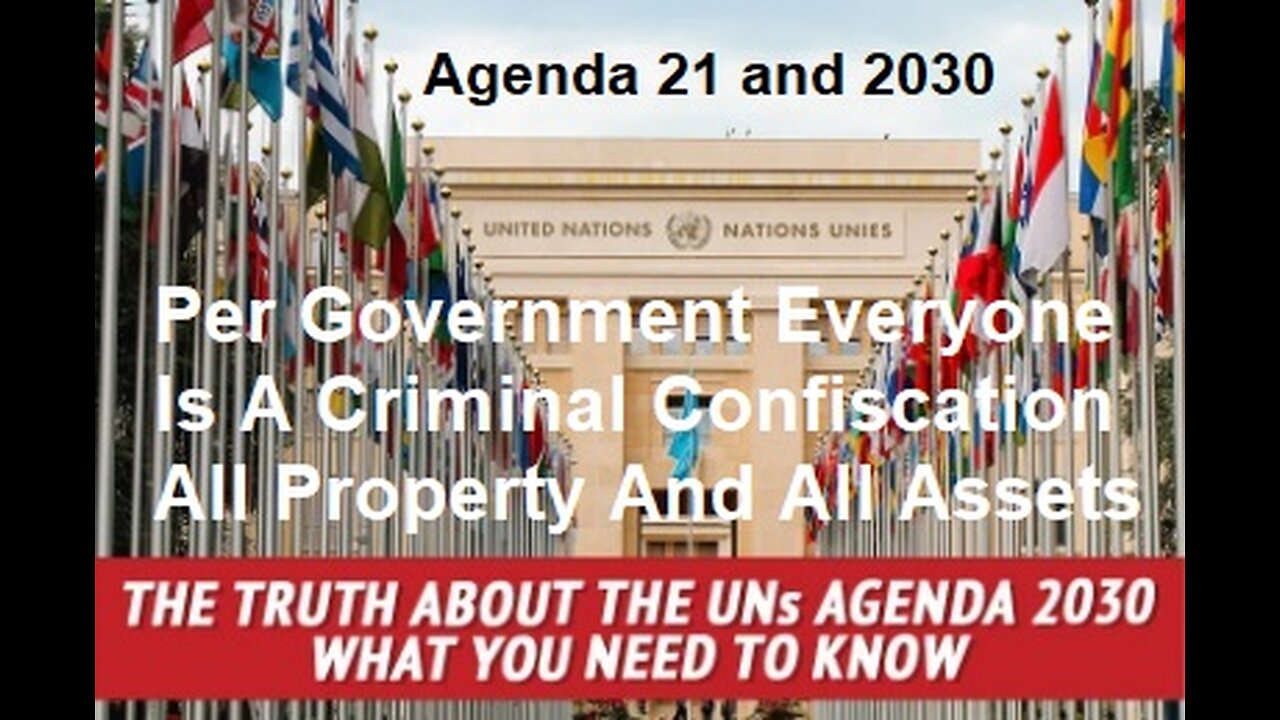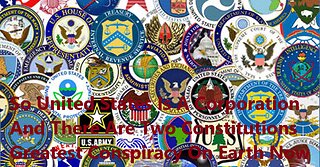Premium Only Content

Per U.S.A. Government Everyone Is A Criminal Confiscation All Property & All Assets
Per U.S.A. Government Everyone Is A Criminal Agenda 21 is a comprehensive plan of action to be taken globally, nationally and locally by organizations of the United Nations System, Governments, and Major Groups in every area in which human impacts on the environment. Agenda 21, the Rio Declaration on Environment and Development, and the Statement of principles for the Sustainable Management of Forests were adopted by more than 178 Governments at the United Nations Conference on Environment and Development (UNCED) held in Rio de Janerio, Brazil, 3 to 14 June 1992.
Per U.S.A. Government DOA-DOJ-FBI-CIA-Etc. Everyone In U.S.A. All Person And Or America Citizens Right Now Today Is A Criminal As of Oct 2023 Need To Be In Jail Or Pay $$$ Fines Now. Per all federal and local police and all government agencies. All The America People Break The Law's Average 3 Times Everyday with A Average Fine of $512 dollars a day. it add up to $512 x 365 days in a year add up to $186,880 Dollars per year in fines per every person alive today right now. also federal and local agencies issue an average of 27 rules for every law over the past decade.
However, the rules issued in a given year are typically not substantively related to the current year’s laws, as agency output represents ongoing implementation of earlier legislation. Remember That Ignorance of the law is a fundamental legal principle in the US that means that if someone breaks the law, they are still liable even if they had no knowledge of the law being broken. According to a 2020 article, the more than 300,000+ laws and regulatory crimes on the federal law books serve little purpose other than inviting arbitrary enforcement by providing prosecutors the tools to charge nearly anyone every day for your life with violating some long-forgotten regulation or law and to pay the fines now or go to jail for everyone in the U.S.A.. Government Every Man, Women, & Child Is A Criminal & Need 2 Go To Jail for life.
A cell phone app is a smartphone add-on that performs functions other than making a phone call, ranging from GPS map to games to medical monitoring and speeding in your car.
So per GPS mapping every street and speed limits of all roads in all town and roads every place of earth we can see you every move and every person driving or moving around town by car or truck... so if you drive 30 mile per hour in a 25 miles per hour zone you get a ticket for speeding etc. your cell phone will tell your speed everyday and night too. most people will get 3-5 tickets a day. you are your brothers keeper and every cell phone in car will get a ticket for speeding and you pay your fine or go to jail.
So Per U.S.A. Government Every Man, Women, & Child Confiscation of all property and all assets you have to pay all tickets and all fines every day of your life. P.S. Remember All The America People Break The Law's Average 3 Times Everyday with A Average Fine of $512 dollars a day.
So per U.S.A. new land reform and confiscation all personal property to pay all new court fines was not only an economic or administrative process of taking and redistributing deeds or legal ownership of land. It was a two party system's republican and democratic parties -led to new mass movement which turned peasants (its you baby) into active participants and which pushed for political and ideological change beyond the immediate economic question of all land confiscation and ownership rights are gone.
If you have a home the state will take it for the fines you own to the state now. you can stay in your old home as a renter with 3 other family to move in with you to help the homeless problem.
In order for housing to be considered affordable, a family should not spend more than 30% of its income on rent. Thus, a working family needs to earn nearly $42 per hour – or roughly $87,000 per year – to afford the average rent in Los Angeles.
In Los Angeles, the median rent is 46.7% or nearly half of median income. 509,404 low-income renter households in the county do not have access to an affordable home.
As of July 10, 2023 - While some states are on a schedule for annual increases to eventually reach $15 an hour, 12 states still adhere to the federal minimum. Although the current federal minimum wage of $7.25 has not budged since 2009, more than 20 states have provided additional increases in 2023.
Why Minimum Wage Isn’t Enough Picture this: Jane Doe is a single adult working a full-time (40 hours per week) minimum wage job. Jane wants to rent a modest one-bedroom apartment. No matter where Jane lives in America, and regardless of whether Jane lives in a state with a minimum wage higher than the federal minimum wage, Jane will be unable to do so.
Why? Because there’s no state in America in which a person working a full-time job that pays minimum wage can afford to rent a one-bedroom apartment.
This shocking fact comes from the National Low Income Housing Coalition’s recently-released report, “Out of Reach 2015.” The report analyzes the Department of Housing and urban Development’s estimated Fair Market Rent (FMR)—which is defined as the 40th percentile of rents for typical, non-substandard rental units, including the cost of utilities—in relation to wages earned in each state. The report estimates the earning necessary to rent one-bedroom and two-bedroom apartments without spending more than 30 percent of a household’s total income on rent.
Let’s look at how the information presented in this report might impact Jane Doe’s apartment search:
To rent a one-bedroom FMR apartment, Jane would need to earn $15.50 per hour. This is more than twice the federal minimum wage of $7.25 per hour. Even the proposed federal minimum wage of $10.10 per hour would be insufficient for Jane to rent an apartment.
To a rent a two-bedroom FMR apartment, Jane would need to earn $19.35 per hour.
If Jane lives in Alaska, California, Connecticut, Delaware, the District of Columbia, Hawaii, Maryland, Massachusetts, New Hampshire, New Jersey, New York, Vermont, Virginia, or Washington, she’ll need to make over $20 per hour to afford a two-bedroom apartment.
The average national FMR price for a one-bedroom apartment is $806 per month. That means Jane would need to work 86 hours per week in her minimum wage job to afford the cost of rent.
Unfortunately for Jane, findings in the “Out of Reach” report show that her situation is unlikely to improve any time soon. Nationally, rents are rising, wages are lagging behind, and there is a limited supply of affordable housing. With all these barriers to renting an apartment, it’s easy to see how Jane might end up doubled-up with family or friends, severely burdened by the cost of her housing, or homeless.
Unless we take action to increase the supply of affordable housing units (Out of Reach suggests America needs 26.1 million more units to meet demand), increase the minimum wage, and decrease the cost of rent, Jane won’t ever be able to afford her apartment.
U.S.A. Government Every Man, Women, Child Is A Criminal Need Two Go To Jail Confiscation All Personal Property And Land Etc.
The Confiscation Acts of 1861 and 1862 and Today Soon 2024
As the Senate met in extraordinary session from July 4 to August 6, 1861, one of the wartime measures it considered was the Confiscation Act, designed to allow the federal government to seize property, including slave property, being used to support the Confederate rebellion. The Senate passed the final bill on August 5, 1861, by a vote 24 to 11, and it was signed into law by President Lincoln the next day. Although this bill had symbolic importance, it had little effect on the rebellion or wartime negotiations.
When Congress again convened in December, Senator Lyman Trumbull of Illinois, chairman of the Judiciary Committee, proposed a more comprehensive confiscation bill. On December 2, 1861, Trumbull introduced the Confiscation Act of 1862 to allow for seizure of all Confederate property, whether or not it had been used to support the rebellion. Before long, however, Trumbull's bill stalled due to ideological differences over the issue of confiscation. Radical Republicans called for a vigorous confiscation bill to seize property and free slaves, but more conservative members worried about expanding the reach of the federal government while denying property owners their constitutional rights.
Early in 1862, a group of moderate senators, led by Ohio’s John Sherman, produced a compromise bill that authorized the federal government to free slaves in conquered rebel territory and prohibited the return of fugitive slaves, while allowing for confiscation of Confederate property through court action. It also allowed the Union army to recruit African American soldiers. Although more aggressive than the first act, the Confiscation Act of 1862 also lacked enforcement capabilities. Loosely enforced by the Lincoln administration, the law was actively undermined by Lincoln’s successor, President Andrew Johnson.
Tracking Everything Everywhere All at Once Cell phone tracking enables you to follow the movements of a person of interest. You can track someone’s location without them knowing by installing a spy app secretly on their target phone. These phone spying apps track almost all targeted phone activities like Calls, SMS messages, Google map’s location, Web history, Social Media sites like Facebook, WhatsApp, Snapchat, Telegram, etc. ... mSpy is a GPS tracker that allows you to remotely track any user’s phone activity.
Asset Forfeiture Law & How to Keep Your Property
asset forfeiture laws allow the government to seize (and sometimes keep) your property when there is evidence that the property was either used in the commission of a crime, or obtained by way of criminal activity.
Most types of property can be seized, including: houses, boats, cars, and money.
Examples of asset forfeiture in cases we handle include: police taking ownership of several kilos of cocaine in a drug possession case.
the government keeping a hunting knife that was used in an assault with a deadly weapon case.
Cops taking a machine that a criminal used to make a counterfeit product.
In our experience, many asset forfeitures take place in:
cases involving drug crimes, and cases involving organized crimes.
Note that before the government can legally forfeit property in these cases,
you typically have to be convicted of a crime related to the property, and
the government has to comply with certain procedural rules.
Our California criminal defense attorneys will highlight the following in this article:
1. What is asset forfeiture?
2. What type of property is subject to forfeiture?
3. What safeguards are there for asset holders?
4. What about asset forfeiture in California drug cases?
5. What is asset forfeiture in organized crime cases?
1. What is asset forfeiture?
Asset forfeiture is when the government takes your property because it suspects the property was either:
used in committing a crime, or
obtained via criminal activity.
Forfeiture can only occur after a civil proceeding where the government files suit against the property itself (not you as the property owner). To win the lawsuit, the government has to show by a preponderance of the evidence that the property was connected to criminal activity.
Note that while the police can seize your property before you get convicted of a crime, they usually cannot forfeit it until you are convicted of a crime. In our experience, forfeiture agents can be very sloppy and often seize property that is:
misidentified as the suspect’s property or
found nearby the suspect’s property but belongs to a innocent party.
1.1. How assets get seized
To get control over your property allegedly connected to criminal activity, forfeiture agents will typically:
take physical possession of the personal property (such as drugs, cash, cars, etc.); order banks or brokers to hold your accounts so that you cannot withdraw any money; and record notices of forfeiture on your real estate to keep you from selling, transferring, or mortgaging it.
Once your property is seized, you can no longer benefit from it or control it unless the court ultimately denies forfeiture and orders the property returned to you and the legal title cleared.
Handcuffs on top of cash
Overzealous and intimidating forfeiture agents often go unchecked and may seize more property than they are legally entitled to.
2. What type of property is subject to forfeiture?
California’s asset forfeiture laws allow police officers and prosecutors to seize most types of property. Some of the most common examples we see are:
a weapon such as gun that is involved in an assault with a deadly weapon case,
telecommunications or computer equipment used to commit a computer crime, such as internet fraud, animals, if you are convicted of animal abuse and cruelty, vehicles used to commit a crime, such as the transport of stolen property or distributing drugs, machines used to break the law, like using a machine to make counterfeit trademarks, illegal drugs or the machinery, land or buildings used to manufacture those drugs, and any personal or real property interest acquired through a pattern of criminal profiteering activity.
In short, all assets subject to forfeiture generally fall under one of the following categories:
contraband involved in the illegal activity (such as narcotics or firearms), proceeds from contraband or other illegal activities (such as cash, real estate, or other things of value), exchanges, which includes cash or other property traded for (or intended to be traded for) contraband, and facilitators, which includes items used in furtherance of criminal activity (such as a getaway car).
3. What safeguards are there for asset holders?
California police used to avoid state forfeiture laws by giving seized property to federal law enforcement, which has laxer regulations. Through “equitable sharing,” the feds sold the property and kept 20%, leaving local and state agencies with 80% of the proceeds.
Though the passage of Senate Bill 443 in 2016 significantly restricted “equitable sharing” and closed ways that California police can overreach and get around state forfeiture laws. Additionally, the bill increases the prosecutors’ burden of proof in certain forfeiture cases so that you have to be criminally convicted for you to lose your property.
Note that the feds can still seize your property based only on probable cause, which is a far lower standard than now required in most state cases.
4. What about asset forfeiture in California drug cases?
In drug cases, you generally must be convicted of an “underlying or related criminal action” before the government can forfeit your:
boat, airplane, or vehicle, money or securities worth up to $40,000, and any real estate (buildings and lands).
There are two exceptions to the above conviction requirement:
You fail to appear in your criminal case, and the government shows that the property in question is related to the crime (called a prima facie case); or Cash or securities worth more than $40,000 can be forfeited with no conviction if the government proves by “clear and convincing evidence” that the money came from – or was going to be used for – illegal drug transactions.
pile of prescription drug bottles
Most California forfeitures involve drugs.
4.1. Required procedures
Depending on your drug case, the government has to follow one of the following procedures before it can forfeit your property:
Summary forfeiture: This is where the government can forfeit the schedule I drugs marijuana, heroin, ecstasy, LSD and peyote without any procedure of any kind. Though if the government seizes marijuana, it has to give it back if you had the right to possess it legally under California’s medical marijuana laws.
Administrative forfeiture: Before the police can forfeit your personal property (no real estate) worth less than $25,000, the police must give public notice of: The property’s description, appraised value, date and location of its seizure, the facts justifying its seizure, and instructions for challenging the taking. Once notice is given, we have 30 days to challenge the seizure of property. If no challenge, the police can sell the property, and keep the proceeds. If we challenge the seizure, then judicial procedures get applied.
Judicial procedures: A civil trial must be held when we have challenged the seizure of your property worth less than $25,000, or a state or local law enforcement agency has seized your property worth more than $25,000. For forfeiture to occur, the government must prove that the property was used to commit a crime or bought with money gained illegally, and you (the property owner “claimant”) were not an innocent owner and knew that a crime was being committed and agreed to it.
Since asset forfeiture can get very complex – and because forfeiture agents are not lawyers – we see law enforcement make procedural mistakes all the time. We have a long track record of using these errors against the government to convince the judge to return your property.
5. What is asset forfeiture in organized crime cases?
For the police to forfeit property in an organized crime case, there has to be a conviction for a crime where there was a pattern of criminal behavior done for financial gain. A pattern means that you committed two or more connected crimes. Common examples in cases we handle include:
child pornography, unlawful under Penal Code 311 PC, extortion, unlawful under Penal Code 518 PC, and receiving stolen property, unlawful under Penal Code 496 PC.
5.1. Required procedures
For the government to legally forfeit property in organized crime cases, the prosecutor must:
file a petition with the court, give a notice of the property to anyone with an ownership interest in it, and publish a notice of the property in a local newspaper (in some cases).
If you have an interest in the property, we have 30 days of receiving the notice to challenge the forfeiture. Then the court will hold a hearing and permit the forfeiture if the prosecutor can prove beyond a reasonable doubt that the property is subject to forfeiture.
Baggies of seized drugs on the ground
Depending on the case, police can seize any property tied to a crime whether or not it is owned by a criminal suspect.
Government Confiscation of Gold: Understanding the Facts
Many investors have heard that the U.S. government confiscated the public's gold years ago. Is it true? Is it a rumor? Could it happen again? This is an issue that comes up time and again with gold investors. Rather than speculate, we believe it's best to consider the facts. Below is a timeline that explains exactly what happened and, more importantly, how today's investors should react and what they can do to make sure they're prepared, in case it happens again.
May 1, 1933 – President Roosevelt's Executive Order 6102 required U.S. citizens to deliver on or before May 1, 1933, all but a small amount of gold coin, gold bullion, and gold certificates owned by them to the Federal Reserve, in exchange for $20.67 per troy ounce. Under the Trading With the Enemy Act of October 6, 1917, as amended on March 9, 1933, violation of the order was punishable by fine up to $10,000 ($167,700 if adjusted for inflation as of 2010) or up to ten years in prison, or both. An exception to the order was listed in section 2 (b) “Gold coin and gold certificates in an amount not exceeding in the aggregate $100 belonging to any one person; and gold coins having a recognized special value to collectors of rare and unusual coins.”
Jan 30, 1934 -- The Gold Reserve Act of January 30, 1934 required that all gold and gold certificates held by the Federal Reserve be surrendered and vested in the sole title of the United States Department of the Treasury and changed the value of the dollar in gold from $20.67 to $35 per ounce.
1954 - In 1954 the Treasury Department amended the Gold Regulations of the original Executive Order to enable the continuance of the exemption of rare coins from the gold confiscation provisions, and they expanded the definition of "coins" with a recognized special value to collectors of rare and unusual coins to include "gold coin made prior to April 5th, 1933 (Federal Register 4309, 4312 1954, as codified in 31 CFR Section 54.20)
Aug 15, 1971 - The price of gold remained fixed from Jan 30, 1934 until August 15, 1971, when President Nixon announced that the United States would no longer convert dollars to gold at a fixed value, thus abandoning the gold standard for foreign exchange.
Dec 31, 1974 - On December 31, 1974, with Executive Order 11825, President Gerald Ford repealed the Executive Order that Roosevelt used to call in gold in 1933. This was necessary because on the same day Congress restored Americans' right to own gold. The limitation on gold ownership in the U.S. was repealed after President Ford signed a bill legalizing private ownership of gold coins, bars and certificates by an act of Congress codified in Pub. L 93-373 which went into effect December 31, 1974. P.L. 93-373 did not repeal the Gold Repeal Joint Resolution, which made unlawful any contracts that specified payment in a fixed amount of money or a fixed amount of gold. That is, contracts remained unenforceable if they used gold monetarily rather than as a commodity of trade.
Oct 28, 1977 - 1977 Congress removed the president's authority to regulate gold transactions during a period of national emergency other than war. However, the Act of Oct. 28, 1977, Pub. L. No. 95-147, § 4(c), 91 Stat. 1227, 1229 (originally codified at 31 U.S.C. § 463 note, recodified as amended at 31 U.S.C. § 5118(d)(2)) amended the 1933 Joint Resolution and made it clear that parties could again include so-called gold clauses in contracts formed after 1977.
Dec 17, 1985 – President Reagan signed into law the Gold Bullion Coin act which allowed the US Mint to produce gold coins from “newly mined domestic sources”. Gold American Eagles went on to become one of the most well known gold coins.
Gold Confiscation in the Future…
So the question remains; could it happen again? Who knows? Of course it is possible; it has been done before and governments in times of stress simply change the laws. As you can see above, gold bullion was forced to be sold to the government in 1933. Then in 1974, that executive order was repealed. Furthermore, in 1977, Congress removed the president’s authority to regulate gold except during a national emergency of war.
It is true that numismatic collector type coins were excluded in the 1933 confiscation. Whether or not they will again be excluded in any future confiscation is completely unknown. There is a logical thought process for excluding collector coins, in that the government was trying to obtain monetary control of gold bullion. The government had no interest in rare and unusual coins of special value to collectors. However, what the government has done in the past is not necessarily indicative of what they will do in the future.
Bottom line – Confiscation did happen. It was repealed, but it could happen again in the future. Laws can and do change.
The History of the 1964 Silver Kennedy Half-Dollar As any numismatist can tell you, a coin that's still in circulation usually isn't worth much. The Kennedy half-dollar seems to fit this bill as well.
Well, not so fast!
Sure, newly minted half-dollar coins aren't worth more than their face value. Earlier editions, however, could be a different story. This is particularly true when it comes to a few special varieties that remain rare today.
Want to know more about the 1964 Kennedy silver half-dollar value? Read on to learn about the history of this coin and how its price has fluctuated since its inception!
Historical Background
The idea for the coin came within hours of JFK's assassination. Eva Adams, director of the Mint, intended for the coin to be a tribute to the president.
After the funeral, the Mint and the Treasury started discussing the details. The Kennedy family served as consultants as well. The main candidates for the new coin were the quarter, half dollar, and dollar.
At the time, the Peace dollar hadn't been minted since 1935. Millions of them were still in the Treasury Department vaults. Replacing all this money would've been troublesome, so the Peace dollar fell out of the race.
The issue with the quarter was that it featured George Washington. Jackie Kennedy didn't want her husband to replace another president. As such, they decided to replace the Ben Franklin half dollar.
Interestingly, changing the Franklin coin required an act of Congress. The law stated that the Treasury could only change coin designs that were 25 years old. The Franklin coin was only in production for 15 years.
Design and Engraving
Work on the new coin began less than a week after the president's death. The plan was to start producing it in January, four weeks away.
The original design was the work of Gilroy Roberts, US Mint chief engraver. At first, he believed the deadline was impossible to meet. To hasten the process, he used some existing designs as the basis for the new coin.
Kennedy's presidential medal was a clear inspiration. The profile sculpture made its way to the coin's obverse (heads) side. Assistant engraver Frank Gasparro sculpted the reverse (tails) side based on the Presidential Seal.
On December 13, the Philadelphia Mint produced the first half-dollar trial strikes. Roberts brought them to Washington for approval. Jackie Kennedy suggested that the hair was too pronounced, which led to a slight revision.
Initial Popularity
The Treasury started offering Kennedy coins on March 24, 1964. They knew that the demand would be high, so they minted no less than 90 million coins.
Fairly soon, it became clear that even these lofty expectations were too low. Before the banks opened, people were already waiting in droves. Lines stretched around every block where coins were available.
Banks tried to respond to high demand by limiting purchases to 40 coins per person. Despite that, customers managed to deplete the initial supply of 70,000 half-dollar coins by noon that day.
Recognizing the excess demand, the Mint increased its target. Still, people continued to collect the Kennedy coins as soon as they arrived. Congress had to order the Mint to keep minting 1964-dated coins into 1965.
From Silver to Copper
Why were Americans so dedicated to collecting these coins? Well, Kennedy's popularity was a big part of it, but there's more to the story.
See, the original 1964 Kennedy half dollar was 90% silver. Due to the excess minting, the government's stockpiles of silver started running low. This led to rising silver prices, so the half-dollar became even more popular.
In response to the short supply of silver, Congress passed the Coinage Act of 1965. The act allowed the addition of copper cores to silver coins. As a result, the 1965 Kennedy half dollar had its silver content dropped to 40%.
As silver prices kept rising, the Treasury soon eliminated it from use in minting. By 1971, the Kennedy coins consisted almost exclusively of copper and nickel.
Over the Years
In the past 59 years, the design of the coin didn't change much. The only exceptions were the special editions, such as the one in 1976.
Around then, the Mint announced new designs for the half-dollar and quarter. The idea was to commemorate the 1976 United States Bicentennial. The redesign featured the Independence Hall in Philadelphia.
After the high mintage of the bicentennial editions, the Kennedy coins started declining in popularity. The silver boom of 1979 didn't help, as many silver coins ended up getting melted for their metal content.
In 2014, the Mint issued another special edition for the half-dollar's 50th anniversary. There were three variations: clad, silver, and .999 gold. All coins are collector's items.
Value of the Coin
These days, it's fairly easy to find a half-dollar in good condition. To make some money on them, you'll need to have a special edition.
One interesting variety is the 1964 half-dollar with accented hair. These are the proofs struck in Philadelphia, and they feature the coin's original design. There's also the 1998 matte finish coin worth a few hundred dollars.
By far, the most valuable Kennedy coin is the SMS (Special Mint Set) edition. These coins feature well-defined strikes and a satin finish. The lack of contact marks indicates someone printed these coins one at a time.
Nobody knows for sure how many SMS edition coins exist. That said, as the rarest non-error Kennedy coin, this edition is very valuable. In 2019, one SMS Kennedy coin set a new record by selling for $156,000.
As for the original 1964 coins, their silver content makes them a bit more valuable. That said, it's hard to get more than $10 for them unless they're in perfect condition.
36th President of the United States: 1963 ‐ 1969
Remarks at the Signing of the Coinage Act
July 23, 1965
Distinguished Members of Congress, ladies and gentlemen:
We are gathered here today for a very rare and historic occasion in our Nation's history.
Before I make some observations that I have made note of here, I want to say to the Congress again, as I do almost daily these days, in the words of the Navy--"Well done."
When I have signed this bill before me, we will have made the first fundamental change in our coinage in 173 years. The Coinage Act of 1965 supersedes the act of 1792. And that act had the title: An Act Establishing a Mint and Regulating the Coinage of the United States.
Since that time our coinage of dimes, and quarters, and half dollars, and dollars have contained 90 percent silver. Today, except for the silver dollar, we are establishing a new coinage to take its place beside the old.
My Secretary of the Treasury, Joe Fowler, is a little stingy about making samples, but I have some here. Joe made sure that I wouldn't put them in my pocket by sending them over here in plastic.
Actually, no new coins can be minted until this bill is signed. So these strikes, as they are called, are coins that we will never use. On one side is our first First Lady, Martha Washington. On the other, a replica of Mount Vernon.
The new dimes and the new quarters will contain no silver. They will be composites, with faces of the same alloy used in our 5-cent piece that is bonded to a core of pure copper. They will show a copper edge.
Our new half dollar will continue our silver tradition. Eighty percent silver on the outside and 19 percent silver inside. It will be nearly indistinguishable in appearance from our present half dollar.
All these new coins will be the same size and will bear the same designs as do their present counterparts. And they will fit all the parking meters and all the coin machines and will have the same monetary value as the present ones.
Now, all of you know these changes are necessary for a very simple reason--silver is a scarce material. Our uses of silver are growing as our population and our economy grows. The hard fact is that silver consumption is now more than double new silver production each year. So, in the face of this worldwide shortage of silver, and our rapidly growing need for coins, the only really prudent course was to reduce our dependence upon silver for making our coins.
If we had not done so, we would have risked chronic coin shortages in the very near future.
There is no change in the penny and the nickel. There is no change in the silver dollar, although we have no present plans for silver dollar production.
Some have asked whether our silver coins will disappear. The answer is very definitely-no.
Our present silver coins won't disappear and they won't even become rarities. We estimate that there are now 12 billion--I repeat, more than 12 billion silver dimes and quarters and half dollars that are now outstanding. We will make another billion before we halt production. And they will be used side-by-side with our new coins.
Since the life of a silver coin is about 25 years, we expect our traditional silver coins to be with us in large numbers for a long, long time.
If anybody has any idea of hoarding our silver coins, let me say this. Treasury has a lot of silver on hand, and it can be, and it will be used to keep the price of silver in line with its value in our present silver coin. There will be no profit in holding them out of circulation for the value of their silver content.
The new coins are not going to have a scarcity value either. The mint is geared to get into production quickly and to do it on a massive scale. We expect to produce not less than 3 1/2 billions of the new coins in the next year, and, if necessary, twice that amount in the following 12 months.
So, we have come here this morning to this, the first house of the land and this beautiful Rose Garden, to congratulate all of those men and women that make up our fine Congress, who made this legislation possible--the committees of both Houses, the leadership in both Houses, both parties, and Secretary Fowler and all of his associates in the Treasury.
I commend the new coinage to the Nation's banks and businesses and to the public. I think it will serve us well.
Now, I will sign this bill to make the first change in our coinage system since the 18th century. And to those Members of Congress, who are here on this very historic occasion, I want to assure you that in making this change from the 18th century we have no idea of returning to it.
We are going to keep our eyes on the stars and our feet on the ground.
Note: The President spoke at 11:21 a.m. in the Rose Garden at the White House. During his remarks he referred to Henry H. Fowler, Secretary of the Treasury.
As enacted, the Coinage Act of 1965 is Public Law 89-81 (79 Stat. 254).
On October 30, 1965, the White House announced that circulation of the new 25-cent piece would begin on November 1. The White House release stated in part, "The new--nonsilver--quarter dollar will be added to the circulation of the traditional 90 percent silver quarter. Both the old and the new quarters are to circulate together.
"Approximately 230 million pieces of the new quarter will be distributed during the week beginning November 1. Initial distribution will be backed by production that will rise from 28 million to 60 million pieces a week during November, and will be still higher thereafter."
The Greatest Silver Dollar Hoard in History The greatest silver hoard in U.S. history was stored in Washington, D.C., at the U.S. Treasury. Inside the massive vaults of the U.S. Treasury were 360,000 bags of Silver Dollars and each bag contained 1,000 coins. This meant 360 million silver dollars were never distributed by the Treasury and sat for decades in the Treasury vaults.
An additional 620 million silver dollars were held in banks across the United States. The American public was content with easy-to-fold paper currency; they didn’t want these big, bulky silver coins in their purses and pockets.
During the 1930s and into the 1950s, the price of silver remained stable, so the demand for silver dollars in the U. S. Treasury was slim. Remember, the Treasury was redeeming their Silver Certificates for U.S. silver dollars. Each silver dollar contains a little over 3/4 of an ounce of pure silver. But as the price of silver rose, the demand from dealers and collectors increased as well.
Dealers and coin collectors from across the country came to Washington to buy silver dollars at face value from the Treasury. Some lucky dealers and collectors received rare dates or in uncirculated condition, while some got coins that were only valued for their silver content. Many members of the public bought every coin they could afford in hopes of “striking it rich” by getting coins that were more valuable than their silver content. Indeed, some members of the public did receive coins worth hundreds of dollars and their stories were widely repeated.
From 1958 to 1963, nearly 90 million silver dollars were purchased from the Treasury. By March 1964, nearly 26 million silver dollars were removed from the U.S. Treasury’s vaults.
Later U.S. Government Sold A Total 982 million Uncirculated Morgan and Peace Dollars Sold By U.S. Treasury’s Vaults. Collecting Silver Dollars Is A Joke Because They Are Not Rare At ALL.
On March 26, 1964, the Treasurer of the United States put an end to the long lines and hopeful prospects. Collectors, who were now aware of the nearly 3 million Carson City coins still unsold by the Treasury, demanded they also be sold. But they would have to wait eight years for the first General Services Administration auctions of Carson City silver dollars to begin.
Silver dollars are among the most popular coins that collectors buy. These large silver coins are valuable both for their numismatic significance and their silver content. While the last circulating 90 percent United States silver dollar coins were struck in 1935, several million 40 percent silver dollars were made at the San Francisco Mint from 1971 through 1976. Since 1983, the United States Mint has struck an array of commemorative 90 percent silver dollars and in 1986 introduced the 0.999-fine American Silver Eagle bullion one-dollar coins, though none of these legal-tender pieces are intended for circulation.
Here’s a brief look at all of the various silver dollars that the United States Mint has produced over the decades:
Early Silver Dollars – Made from 1794 through 1803, the early silver dollar coins are highly scarce and quite expensive. Flowing Hair silver dollars, made in 1794 and 1795, represent the first design type of the silver dollar coin and cost about $2,200 and up for a specimen grading Good-4. Common examples of the Draped Bust silver dollar type, most widely recognized by the rare, multi-million-dollar 1804 Draped Bust dollar (a special presentation piece that was actually produced in 1834), cost $1,000 and up for a Good-4 specimen. The Flowing Hair and Draped Bust silver dollars were both designed by Robert Scot.
Liberty Seated Dollars – Christian Gobrecht’s classic Seated Liberty design, seen on most U.S. silver denominations in the 19th century, graced the dollar coin from 1840 through 1873. These coins are very scarce in original condition and are priced at about $300 and up for a “common” Good-4 specimen.
Trade Silver Dollars – These silver dollar coins, not intended for circulation in the U.S., were designed by William Barber and struck from 1873 through 1885. They were primarily produced for trade with Asia. The most common Trade dollars sell for around $150 and up in a grade of Very Good-8, and many pieces are covered by “chop marks,” or insignias that were counterstamped onto the coins by various Eastern merchants.
Morgan Silver Dollars – By far the most popular silver dollar type, Morgan silver dollars (officially known as the “Liberty Head silver dollar”) were designed by George T. Morgan and were produced from 1878 through 1904, and again in 1921. Morgan dollars are commonly sold to non-collectors and junk silver investors, though their most enthusiastic market is found among hobbyists who collect one of each date and mintmark variety. While common Morgan dollars can be bought for a small premium over their current silver spot value, some Morgan silver dollars, such as the rare Carson City Mint specimens, sell for hundreds and even thousands of dollars each.
Peace Silver Dollars – In 1921, Anthony de Francisci designed the Peace dollar, which shows a head of Miss Liberty similar to that on the Statue of Liberty in New York. Like Morgan dollars, Peace silver dollars have a wide collecting base, though the run of this series was much shorter. Made only until 1935, the Peace dollar is a relatively common type, with some pieces selling for a small amount over their silver spot value. Scarcer Peace dollars, such as the 1921 and 1928 silver dollars, are worth hundreds.
Eisenhower Silver Dollars – Regular-issue Eisenhower dollars struck for circulation are actually made from a copper-nickel composition, though the United States Mint did make a limited number of 40 percent silver dollars in both uncirculated and proof varieties at the San Francisco Mint. These 40 percent silver Eisenhower dollars were made from 1971 through 1976, and some sell for less than $10. The Eisenhower dollar series ended in 1978 and was followed by the Susan B. Anthony dollar coins in 1979. All Susan B. Anthony dollars are made from a copper-nickel clad composition.
Collecting silver dollars can be a lot of fun and doesn’t have to be an expensive venture. One of the most affordable ways to sample everything that U.S. silver dollars have to offer is to build a silver dollar type set, which would include one example of each coin mentioned above. Such a coin collecting goal would cost at least $1,700 to $2,000 and makes a beautiful assemblage of some of America’s finest and most important coins.
The Truth about the UNs Agenda 2030 — What You Need to Know We live in a world of misinformation, and it is hard to sort fact from fiction—even more so when the facts are distorted. With misinformation coming our way day and night, we’ve got to decipher the truth. Once we have the actual facts, it is up to each of us to determine how it affects us and the world around us.
“Agenda 2030” – the central United Nations platform for sustainable development — is a perfect case in point. It contains 17 goals that 193 member states (including the U.S.) pledged to ensure. It is a convoluted, wordy document that focuses on the idea of a global partnership to eradicate issues relating to global human rights, poverty, and the environment.
Rather than just picking up on sound bites, here is the truth about Agenda 2030, straight from the original sources (The United Nations: Department of Economic and Social Affairs). Use this information to form your own opinion.
The Basics Facts of Agenda 2030
The Heads of State and Government and High Representatives met at the United Nations Headquarters in New York September 25-27, 2015, to create new global Sustainable Development Goals.
The 2030 Agenda for Sustainable Development is a resolution adopted by the UN General Assembly in 2015. You can read it in its entirety here.
The 2030 Agenda has 17 Sustainable Development Goals and 169 targets. According to the UN, “All countries and all stakeholders, acting in collaborative partnership, will implement this plan. […] The Goals and targets will stimulate action over the next fifteen years in areas of critical importance for humanity and the planet.”
In the 2030 Agenda Declaration, the UN declares, “On behalf of the peoples we serve, we have adopted a historic decision on a comprehensive, far-reaching and people-centred set of universal and transformative Goals and targets. We commit ourselves to working tirelessly for the full implementation of this Agenda by 2030.”
It is important to note that Agenda 2030 was written in 2015, well before COVID-19. However, the UN has a COVID-19 Response for the Sustainable Development Goals and is pushing Agenda 2030 in the wake of the pandemic, which may explain why you are hearing about it more often now.
The UN’s COVID-19 Response website says, “The pandemic is an unprecedented wake-up call, laying bare deep inequalities and exposing precisely the failures that are addressed in the 2030 Agenda for Sustainable Development and the Paris Agreement on climate change. Leveraging this moment of crisis, when usual policies and social norms have been disrupted, bold steps can steer the world back on track towards the Sustainable Development Goals. This is the time for change, for a profound systemic shift to a more sustainable economy that works for both people and the planet. The Sustainable Development Goals are vital for a recovery that leads to greener, more inclusive economies, and stronger, more resilient societies.”
The 5 Ps of Agenda 2030
So, what exactly does the United Nations plan to do with Agenda 2030? According to The 2030 Agenda for Sustainable Development Primer, “At the heart of the 2030 Agenda are five critical dimensions: people, prosperity, planet, partnership and peace, also known as the 5P’s.”
People: To end poverty and hunger for all.
Planet: To protect the planet from degradation.
Prosperity: To ensure “all human beings can enjoy prosperous and fulfilling lives and that economic, social and technological progress occurs in harmony with nature.”
Peace: To foster peaceful and inclusive societies.
Partnership: To strengthen global solidarity.
The 17 Goals of Agenda 2030
In order to achieve the 5 Ps, 17 Sustainable Goals were created by the United Nations. Here are the goals directly from the 2030 Agenda for Sustainable Development:
Goal 1. End poverty in all its forms everywhere.
Goal 2. End hunger, achieve food security and improved nutrition and promote sustainable agriculture.
Goal 3. Ensure healthy lives and promote well-being for all at all ages.
Goal 4. Ensure inclusive and equitable quality education and promote lifelong learning opportunities for all.
Goal 5. Achieve gender equality and empower all women and girls.
Goal 6. Ensure availability and sustainable management of water and sanitation for all.
Goal 7. Ensure access to affordable, reliable, sustainable and modern energy for all.
Goal 8. Promote sustained, inclusive and sustainable economic growth, full and productive employment and decent work for all.
Goal 9. Build resilient infrastructure, promote inclusive and sustainable industrialization and foster innovation.
Goal 10. Reduce inequality within and among countries.
Goal 11. Make cities and human settlements inclusive, safe, resilient and sustainable.
Goal 12. Ensure sustainable consumption and production patterns.
Goal 13. Take urgent action to combat climate change and its impacts.
Goal 14. Conserve and sustainably use the oceans, seas and marine resources for sustainable development.
Goal 15. Protect, restore and promote sustainable use of terrestrial ecosystems, sustainably manage forests, combat desertification, halt and reverse land degradation and halt biodiversity loss.
Goal 16. Promote peaceful and inclusive societies for sustainable development, provide access to justice for all and build effective, accountable and inclusive institutions at all levels.
Goal 17. Strengthen the means of implementation and revitalize the global partnership for sustainable development.
Keep in mind that each goal also contains several targets, as well. For example, Goal 2 includes, “2.1: By 2030, end hunger and ensure access by all people, in particular the poor and people in vulnerable situations, including infants, to safe, nutritious and sufficient food all year round.” Goal 16 includes, “16.9: By 2030, provide legal identity for all, including birth registration.”
There are 169 targets total, all of which break down goals in this way.
Implementation of Agenda 2030
Lofty goals like these require lots of action, and Agenda 2030 is not lacking in calls for governments to “act.”
The Agenda repeatedly refers to the Financing for Development Outcome Document as a major part of the action plan for achieving goals. While it’s hard to say how “actionable” the declarations in the Outcome Document actually are, they shine a light on the priorities and mindset of the groups writing the Agenda. Taken directly from the Document itself, these include:
Expanding Taxation
“We commit to enhancing revenue administration through modernized, progressive tax systems, improved tax policy and more efficient tax collection. We will work to […] broaden the tax base. […] We welcome efforts by countries to set nationally defined domestic targets and timelines for enhancing domestic revenue as part of their national sustainable development strategies and will support developing countries in need in reaching these targets.”
Empowering the IMF and World Bank to Access Financial Information
“To help to combat illicit flows, we invite the International Monetary Fund (IMF), the World Bank and the United Nations to assist both source and destination countries. We also invite appropriate international institutions and regional organizations to publish estimates of the volume and composition of illicit financial flows […] [W]e will encourage information-sharing among financial institutions to mitigate the potential impact of the anti-money-laundering and combating the financing of terrorism standard on reducing access to financial services.”
Strengthening Regulations on Private Business to Achieve “Public Goals”
“We will develop policies and, where appropriate, strengthen regulatory frameworks to better align private sector incentives with public goals, including incentivizing the private sector to adopt sustainable practices, and foster long-term quality investment.”
Growing Services for Immigrants in Their Host Countries
“We recognize the positive contribution of migrants for inclusive growth and sustainable development in countries of origin and transit and destination countries […] We will work to ensure that adequate and affordable financial services are available to migrants and their families in both home and host countries.”
Footing a 100-Billion Dollar Annual Bill for “Clean Energy”
“We will promote both public and private investment in energy infrastructure and clean energy technologies […] with a combined potential to raise over $100 billion in annual investments by 2020.”
There are many other action items in the document. Click here to see them all.
The Concern regarding Agenda 2030
If we’re being honest, there is quite a lot of mistrust when it comes to Washington or the United Nations. We have seen firsthand how FEMA has failed to save us in times of crisis. So, when looking at this giant agenda that is full of hyperbolic language, it is easy to see why some people don’t trust it.
How is the UN going to “end poverty in all its forms everywhere” by 2030? It just doesn’t seem that possible given their track record.
Moreover, the language used in Agenda 2030 has some worried it is presenting a “New World Order.” This is because it uses all-encompassing language, such as “for all” and emphasizes the need for a global partnership.
Instead of the United States of America, people are fearful that our own current laws will cease to exist if we continue to hand U.S. sovereignty over to an international government.
However, according to the United Nations, “The Sustainable Development Goals (SDGs) are not legally binding. Nevertheless, countries are expected to take ownership and establish a national framework for achieving the 17 Goals.”
Prepare Now for Agenda 2030 Issues
Take time to read Agenda 2030 and the Financing for Development Outcome Document in full and form your own opinion. While the goals may seem all fine and good, we’re all familiar with the phrase, “No good deed goes unpunished.”
As danger in the world grows and concern for our government handing over its independence continues, it is always important to practice preparedness. Learn basic survival skills, develop relationships with people you can trust, purchase land, stock up on food supplies, and stay aware.
Don’t rely on the government or the United Nations to save the world. Learn how to save yourself, friends.
UN Report Calls For Decriminalization Of Sex Between Adults/Children Age 8+Up
Back to Agenda 21
The Deliberate LIE of the story of “saving the environment” – which is actually being destroyed by these same Elitist Jews, not the population of the world – is nothing but a “cover” story to keep the people in the dark while the “Plan” proceeds at break-neck speed. After all, if people caught on to the truth of what is going on, they might make some attempt to survive!
This is nothing less than blatant, RAW, Communism! And we, the people, are paying for it. Cities, towns, and states are being seduced into destroying their own rights, and the rights of their fellow Americans, by federal grants and “easy” money to implement these diabolical plans.
Undoubtedly, residents of any town, county, or city in the United States that treasure their freedom, liberty, and property rights couldn’t care less whether it’s called Agenda 21 or smart growth. A recent example of this can be found in Carroll County, Maryland, where a smart growth plan called Pathways was drafted by the County Planning Department in 2009. It proposed a breathtaking reshuffling of land rights:
Rezoning of thousands of acres of beautiful, low-density agricultural farmland and protected residential conservation land into office parks
Down-zoning of agriculture land to prevent future subdivision by farmers
Up-zoning of low-density residential land around small towns into higher density zoning to permit construction of hundreds or possibly thousands of inclusive housing units, including apartments and condominiums
Inclusive housing with placement of multi-family construction on in-fill lots within existing residential single family communities
Endorsement of government-sponsored housing initiatives (subsidies) to ensure healthier, balanced neighborhoods
“Balanced” means putting prostitutes, drug addicts, street people, gang members, etc. as tenants in the same buildings with middle class families. This has been going on in San Francisco for years. Upper middle class Americans bought up-scale condominiums in up-scale high rise buildings in San Francisco only to see the City give HUGE subsidies (sometimes paying as much as $4,000 per month) to put these indigent people in the same building. Their goal? To destroy the value of the condominiums owned by the upper middle class thereby destroying the largest investment they owned.
The indigent people who were put in these buildings at great expense to the city would defecate in the elevators and in the hallways, leave trash everywhere, put graffiti all over everything inside and outside the building, buy and sell dope on the property, bring their thug friends into the building, and do everything possible to make the decent tenants miserable and frightened.
https://sdgs.un.org/2030agenda
https://www.un.org/esa/socdev/rwss/2016/full-report.pdf
Agenda 21 and 2030 Agenda for Sustainable Development is a non-binding, voluntarily implemented action plan of the United Nations with regard to sustainable development. It was adopted by more than 178 countries at the Earth Summit in Rio de Janeiro, Brazil, in 1992.
-
 5:19
5:19
What If Everything You Were Taught Was A Lie?
22 days agoUnited States Is A Corporation And There Are Two Constitutions Greatest Conspiracy On Earth
3.99K7 -
 LIVE
LIVE
Wendy Bell Radio
6 hours agoThey Don't Have The Cards
11,252 watching -
 LIVE
LIVE
Dear America
10 hours agoTrump Sends Yuge AMERICA FIRST Message To The World! + Oscars Stays Woke!
5,494 watching -
 LIVE
LIVE
Jeff Ahern
1 hour ago $0.82 earnedMonday Madness with Jeff Ahern (6am Pacific)
604 watching -
 16:55
16:55
Clownfish TV
13 hours agoThe Oscars Just Jumped the Shark...
33K11 -
 7:55
7:55
Cooking with Gruel
13 hours agoCooking with Lara Trump on My View
23.2K6 -
 30:51
30:51
Survive History
22 hours ago $8.79 earnedCould You Survive Behind the Frontline in World War Two?
21.2K3 -
 9:28
9:28
Dr. Nick Zyrowski
12 hours agoI Quit Caffeine For 30 Days - This Happened!
23.6K6 -
 25:54
25:54
RealitySurvival
15 hours agoTop 3 Threats In This New Timeline!
30.6K2 -
 7:00
7:00
State of the Second Podcast
19 hours agoCan Your Firearms Handle the Heat?
19.5K2